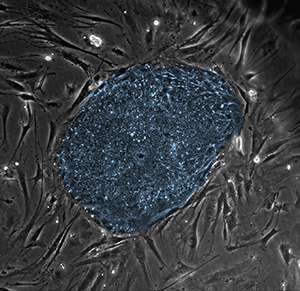Location map for signaling protein identifies key molecular targets in human embryonic stem cells

Human embryonic stem cells (hESCs) retain the ability to form any cell type in the body. They do this thanks to the interplay of many proteins, including one involved in cell signaling known as extracellular signal-regulated kinase 2, or ERK2. By detailing all the sites in the genome where ERK2 binds, a team led by A*STAR scientists has now mapped the regulatory network by which this enzyme keeps hESCs in a state of self-renewing pluripotency.
"ERK2 appears to be involved in active transcription of a large number of genes in hESCs," says senior study author Huck-Hui Ng, executive director of the A*STAR Genome Institute of Singapore. "This is a first whole-genome map to describe the kinase-chromatin interactions in human stem cells" he adds.
Ng and his collaborators—who included researchers from A*STAR, the National University of Singapore and the Max Planck Institute for Molecular Genetics in Berlin, Germany—used a technique for unraveling interactions between proteins and DNA called ChIP-seq to pinpoint some 12,000 sites where ERK2 binds to chromosomes in hESCs. They found that close to two-thirds of these ERK2 binding sites occurred near so-called 'promoter' regions of DNA that initiate transcription of particular genes. They also showed that these promoters activate an assortment of genes variously involved in metabolic pathways and cell cycle progression, including those essential for the survival, proliferation and pluripotency of the cells (see image).
The researchers then looked for transcription factors that ERK2 might interact with to activate these genes. Based on the type of DNA motifs found at ERK2 binding sites, they identified four candidate interaction partners. Silencing three of these candidates had no effect on hESC identity, but depleting a transcription factor called ELK1 led to the loss of pluripotency in the cells, the researchers noted.
Ng's team showed that ELK1 has a dual function. It works with ERK2 to activate the expression of metabolism-related genes. Yet, in the absence of ERK2, ELK1 can also repress genes involved in differentiation and lineage-commitment. "The balance between active gene expression and repression of differentiation genes is characteristic for the capacity of embryonic stem cells to become more specialized cells," explains Jonathan Göke, a postdoctoral fellow in Ng's lab and the first author of the study.
"The dual role of ELK1 indicates that a change in activation most likely will affect repression as well, and vice versa," Göke adds. "Therefore, activation and repression are to some degree two sides of the same coin."
More information: Göke, J., et al. Genome-wide kinase-chromatin interactions reveal the regulatory network of ERK signaling in human embryonic stem cells, Molecular Cell 50, 844–855 (2013). dx.doi.org/10.1016/j.molcel.2013.04.030
Journal information: Molecular Cell

















